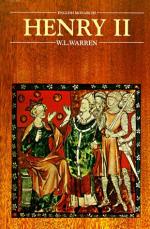In 1167 Diarmait returned to Ireland with a little band of allies, the pioneers of the English conquest. Others followed the next year, among them Strongbow’s uncle, Hervey of Mount Moriss, a famous soldier in the French army, distinguished for his beautifully proportioned figure, his delicate long hands, his winning face, and graceful speech. With him went Nesta’s son Robert Fitz-Stephen, a powerful man of the Norman type, handsome, freehanded, sumptuous in his way of living, liberal and jovial, given to wine and dissipation. His nephew, Meiler Fitz-Henry, showed stronger traces of Welsh blood in his swarthy complexion, fierce black eyes, and passionate face. The knights carried on the war with the virtues and vices of a feudal chivalry, with a frank loyalty to their allies, a good comradeship which recognized no head but left each knight supreme over his own forces, a magnificent daring in the face of overwhelming forces, and a joyful acceptance of the savage privileges of slaughter and rapine which fell to their lot. “By their aid Diarmait began first to take breath, then to gain strength, and at last to triumph over his enemies.” The Irish, however, rallied under the king of Connaught against the traitor who had brought the English into their land; and Diarmait was forced to conclude a peace and promise to receive no more English soldiers.
Meanwhile other knights were preparing for the Irish expedition. Maurice Fitz-Gerald encamped on a rock near Wexford. Another Fitz-Gerald, Raymond the Fat, fortified his camp near Waterford. In August 1170 came Earl Richard himself, who had crossed to France in search of Henry, and with persistent importunity implored for leave to join the Irish war. Henry, at that moment busy in his last negotiations




